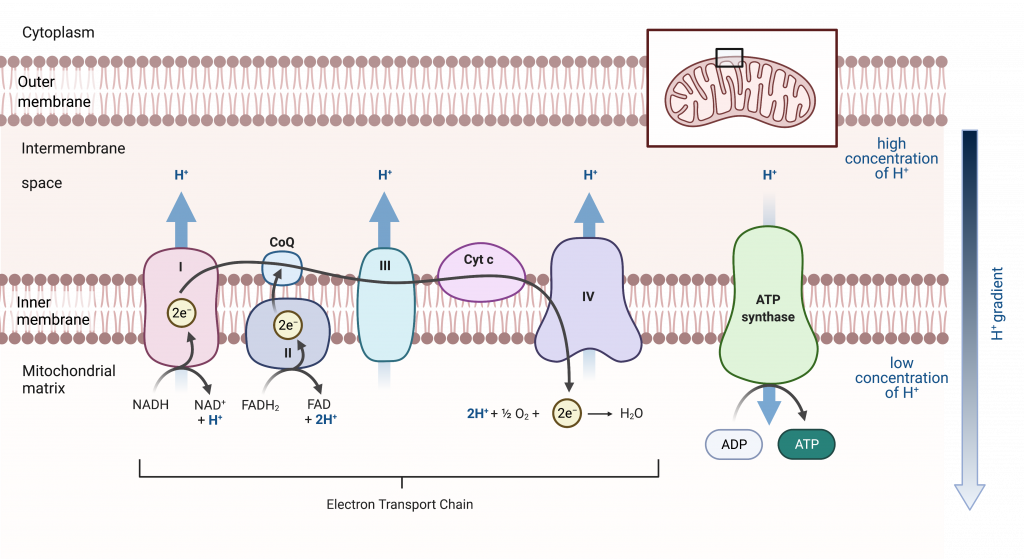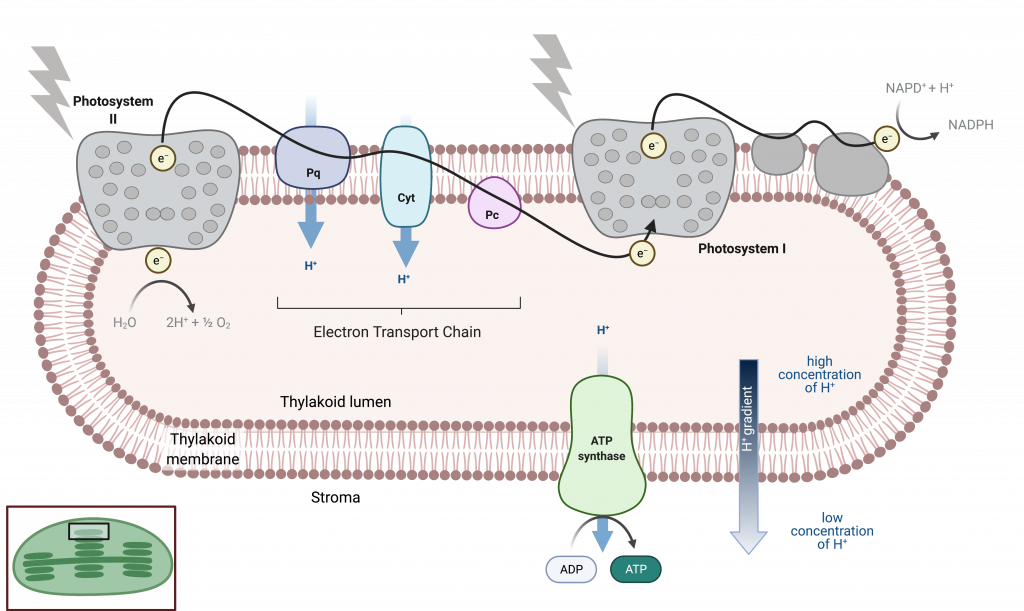22.4 Electron Transport Chains in Respiration and Photosynthesis
Chemiosmosis produces ATP in both chloroplasts and mitochondria using the same mechanism. In both cases, an electron transport chain maintains the hydrogen ion gradient that powers chemiosmosis. There are differences between the electron transport chains in the mitochondrion and the chloroplast, however. The original source of the electrons, the specific components of the electron transport chain, and the final electron acceptor all differ.
The Electron Transport Chain in the Mitochondrion
The electron transport chain in mitochondria is the last component of aerobic respiration and is the only part of glucose metabolism that directly uses atmospheric oxygen. In each mitochondrion of a eukaryotic cell, the electron transport chain is present in many copies within the inner mitochondrial membrane. Electrons are shuttled to the first complex of the electron transport chain by NADH and FADH2, which are the reduced forms of the two electron carriers used in respiration.
The electrons are then passed from protein complex to protein complex. Each complex has a greaterelectronegativity than the one before it such that energy is release with each transfer. Finally, electrons are passed to oxygen, which is more electronegative than any of the protein complexes. Two electrons combine with an oxygen atom and two hydrogen ions to form water, which is a byproduct of aerobic respiration.
This is the reason that organisms like us require oxygen to live. Without oxygen, the electron transport chain would not function, the hydrogen ion gradient between the intermembrane space and the matrix would equalize, and most ATP production would cease. Cessation of ATP production is incompatible with life.

The Electron Transport Chain in the Chloroplast
Photosynthesis functions as a series of two major steps, the light-dependent reactions and the Calvin cycle. The light-dependent reactions transform light energy into the chemical energy of ATP and NADPH. The Calvin cycle then uses these molecules to build a carbohydrate. ATP is produced via chemiosmosis, the same mechanism as in cellular respiration; thus the light-dependent reactions include an electron transport chain.
As in the intermembrane space of the mitochondria during cellular respiration, the buildup of hydrogen ions inside the thylakoid lumen creates a concentration gradient. The passive diffusion of hydrogen ions from high concentration (in the thylakoid lumen) to low concentration (in the stroma) is harnessed to create ATP.

Comparing the Electron Transport Chain in the Mitochondrion and Chloroplast
The electron transport chains in the mitochondrion and chloroplast have the same function — to maintain a gradient of hydrogen ions that can be used to power the endergonic process of producing ATP by chemiosmosis. There are differences between the two processes, which are summarized below.
| Ultimate source of energy | Electron Donor | Electron Acceptor | Region of high [H+] | Region of low [H+] | |
|---|---|---|---|---|---|
| Mitochondrion | Glucose (or another food molecule) | NADH and FADH2 | Oxygen (O2) | Intermembrane space | Matrix |
| Chloroplast | Light | Water | NADPH | Thylakoid lumen | Stroma |
process in which organisms convert energy in the presence of oxygen
ability of an atom to attract electrons

